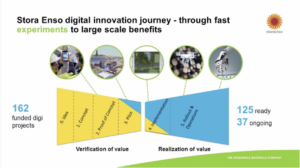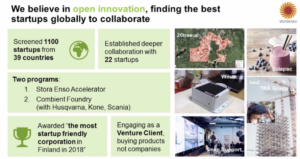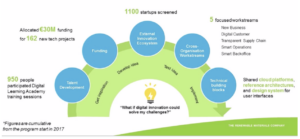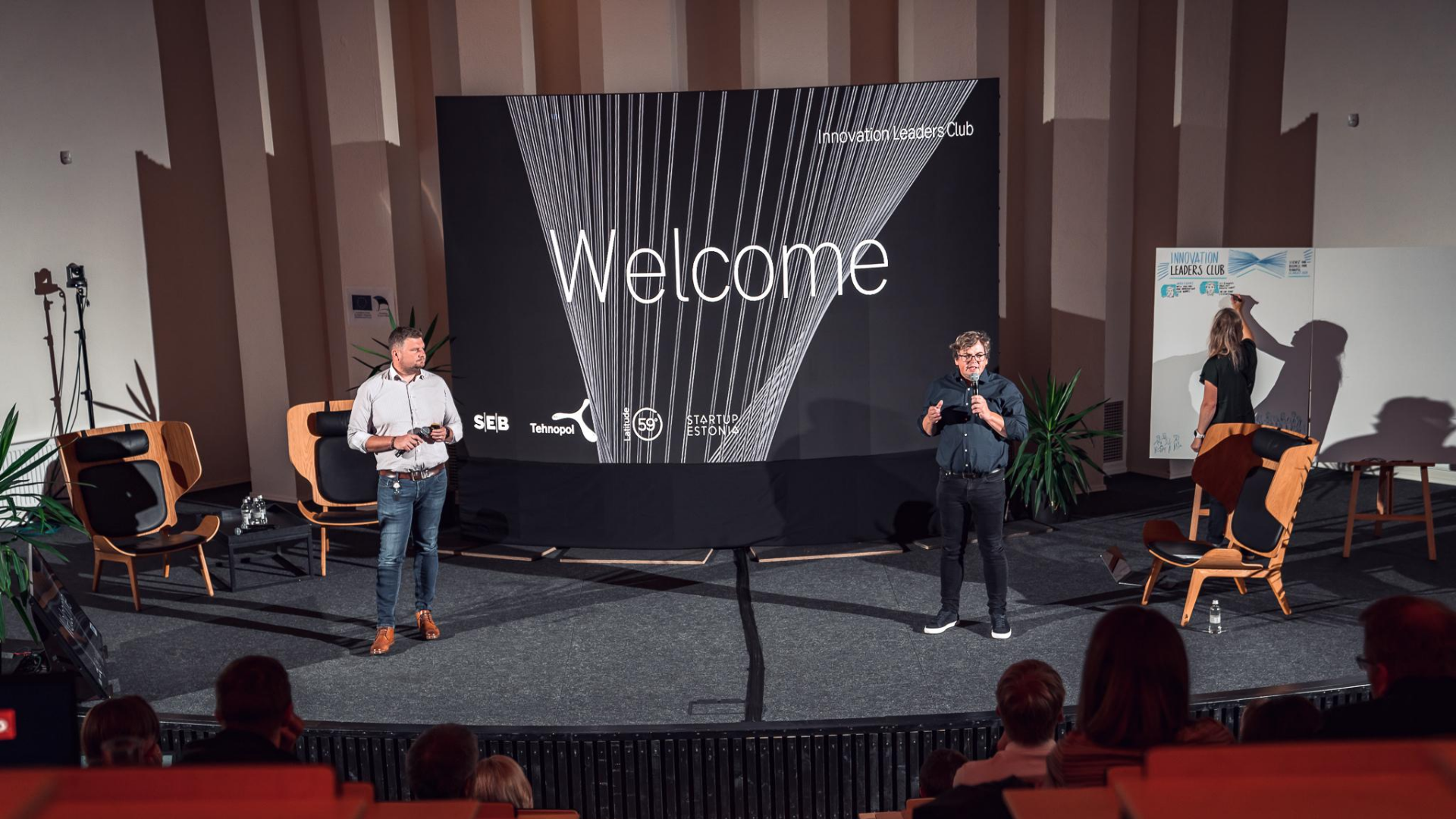INNOVATION LEADERS CLUB KICK-OFF: MISSION IS TO CREATE A COMMUNITY FOR INNOVATORS IN ESTONIA
On the 26th of August, the first event of Innovation Leaders Club, created together by Tehnopol and SEB, took place. Club’s purpose is to start a still missing community for innovators, including corporates and startups’ representatives. In addition to new business opportunities, the Club will offer a chance to learn through workshops, discussion panels, and visits to different companies.
SEB Chief of Business Innovation Mart Maasik told that working in the bank and opening innovation centers has given him an insight into many companies who wish to accept the challenges that the future holds. So, they start experimenting but there’s a lack of system and cooperation. “We believe that systematic cooperation that crosses industries would help all the participants in innovation,” told Maasik. “Innovation Leaders Club tries to solve that missing community problem and raise awareness, create common understandings and knowledge.
In Maasik’s opinion, the participants of the first event made an ideal cocktail of the potential members – half of them being big corporations and the other half being startups and scaleups with few innovation enthusiasts, who didn’t represent any organization.
Tehnopol Chief of Business Development Martin Goroško said that Tehnopol, which has been working with startups for years, saw the gap in the market where startups and corporations could work together. The Club will look at every member individually and helps to find their challenges and opportunities in business and finds the right cooperation partner from the other members. The Club will also offer extensive mentoring – in the juridical aspects and marketing, technological consultation, and even product development. The Club will soon start an online channel for communication between the members.
Useful tips from Scandinavia
Even the opening event of Innovation Leaders Club offered practical value – many discussion panels took place and Stora Enso Chief Digital Officer Samuli Savo shared his experiences in the company’s internal innovation. The first panel was about useful tips from Scandinavia and was participated by Mahesh Kumar, who is the founder of North Europe’s biggest innovation house Epicenter, and a serial entrepreneur. He has been working as an advisor and partner with big corporations for the last five years. The other participant was Jeff Abbott – an innovator of big corporations, entrepreneur, and investor who has been working with the cooperation between corporations and startups. He is also a co-author of “Blitzscaling”.
Mahesh Kumar said that innovation is like going to the gym – it only works if you do it regularly. Rebranding and designing a new logo is no innovation. Kumar emphasized that the chiefs of big corporations should look at innovation as the hedge funds. “If you analyze, how the best hedge funds work, it’s a massacre. Hundreds of companies, ideas, and people will never fulfill their dreams. 6-7 companies won’t earn anything, few will double the money and only one will 10X the initial investment.
Kumar said that although many projects will never work out, the management should still be brave and take on new projects.
Jeff Abbott agreed with Kumar. “I often hear CEOs say that their company’s position is so strong that they have time to think about if and what they should innovate. The reality is that you can never know when your competitor will come. In every ecosystem I visit, I meet about five entrepreneurs who solve the same problem as the entrepreneurs in the last city I was in. There are also a bunch of entrepreneurs that I never meet. And finally, there are those who five years ago started solving a different problem and reached a point when it didn’t work out. Then they decided to start solving the same problem as the others are doing it much better. In that situation you have two choices – change the direction or exit the market.
How to get the best employees to drive your innovation project?
In terms of the opening event, the participants were asked, which innovation tools they are using in their companies and sprint (aka design sprint, Google sprint) was a dominant answer. Abbott said that sprint is used in many companies and the problem with it is that they get so many choices and it’s hard to choose the right one. Abbott also said that it’s important to know what’s going on in the startup ecosystem, but it can also be useless. “An employee of Johnson & Johnson told me that by the time they find an interesting startup, there are already 10 more people doing the same thing and any of the competitors may already be working with them”, he told. In the end, the innovation laurels are cut by the winners. So, in addition to innovative ideas, it’s important to think rationally and know the capabilities of the company – how fast can those ideas be put to work?
Both Kumar and Abbott said that stimulus is important when it comes to employees’ commitment to innovation projects. “If there’s a tempting bonus, the normal wage should be cut during the project. Other ways there’s no risk in case of success or failure”, said Abbott.
Mahesh brought an example from Samsung, where they encourage employees to start new companies. Samsung will take a percentage of the company and while working in Samsung and starting the new company, the employee will be paid the normal wage.
Swedish innovation success formula: small market, strong social system, and positive attitude
Mahesh Kumar brought out three factors that guarantee a successful innovation environment in Sweden:
- Strong social system: it’s easier to innovate and start a business when you get an income of 1500-2500 euros to pay your bills and raise your kids in case of failure.
- Small market: small market doesn’t carry a big risk if the projects are not successful. For example, Google tries their Android and cloud software developments in Scandinavia. The market makes such a small percentage of their overall market that the cost of failure is not high for the company. But it’s very good for the organization if the project succeeds.
- Positive curiosity and attitude towards life: curiosity about the future. Strangely the people in Northern Europe have a more positive attitude towards the future than the people in Southern Europe. That’s an important factor. It will not help in terms of succeeding but it’s easier to start projects.
STORA ENSO – THE PURPOSE OF DIGITAL INNOVATION IS TO MAKE OUR EMPLOYEES’ LIFE EASIER
In the Innovation Leaders Club opening event, Stora Enso’s Chief Digital Officer Samuli Savo shared his experience. Stora Enso is the oldest company on the planet – it’s 700 years old! At first, it was a mining company but today, it has positioned itself as a producer of renewable materials, offering jobs to 26 000 people in 30 countries with a yearly profit of 10,5 billion euros.
Savo has been leading digital innovation in Stora Enso for three years and during the time, the company has funded 162 innovation projects, out of which 125 have ended and 37 are still running.

All Stora Enso’s innovation projects pass through the so-called digital tunnel shown in the picture.
Savo admitted that many of those projects didn’t work out and have been good learning lessons. Running and leading innovation projects in Stora Enso is transparent. Everyone can get funding for their idea. Savo emphasized that if a company wants to have good innovation habits, a transparent structure must be created, and the company has to offer funding. But no one innovates alone. Stora Enso has investigated 1100 startups in 39 different countries and has started cooperation with 20.
One of the KPI-s in Stora Enso is the number of startups turned into real business projects out of every analyzed startup. With Husqvarna, Kone and Scania, and many other big Swedish and Finnish corporations, Stora Enso has created a network to find the best startups together.

Stora Enso prefers to use the services of startups instead of buying them at a very early stage.
Savo recommended following their example. “We rarely buy up companies. We prefer to be their business client; we buy their products and services at an early stage. Cooperation with startups does mean investing in them.
Samuli Savo concluded his story of experiences by saying, “Our goal is to improve our employees’ work life.”

Stora Enso 5 principles for digital innovation to succeed.
FEELINGSTEAM’S AND MINDTITAN’S COOPERATION WITH CORPORATIONS – LEARNING LESSONS AND RECOMMENDATIONS
In the last panel of the event, two of Estonia’s AI and machine learning startups, FeelingSteam and Mind Titan, shared their experiences in cooperation with corporations. FeelingSteam helps to turn conversations with the clients into sales. From FeelingSteam the participant of the panel was Lauri Ilison, co-founder, and Head of Technology. Kristjan Jansons, CEO of MindTitan told that his company helps corporations to understand and implement AI.

Elisa, the first customer of MindTitan, is their customer to this day and the overview of their cooperation is impressive.
Both startups got their clients from hackathons and they recommend participating in hackathons to all startups.
Recommendations to startups
Kristjan Jansons recommended avoiding doing cooperation projects for free. “We have done few cooperation projects for free and in that case the commitment by the corporations is low. So don’t take full price for your product but take something which will ensure the commitment by the corporation.
FeelingSteam approaches clients in their way and doesn’t offer client-based solutions. “We have a platform that offers a full solution, and we are constantly improving it based on the feedback of our clients. In that way, companies can use functions that they would have never thought about but their competitor, for example, needed it,” told Lauri Ilison.
What can big corporations do to make life easier for startups?
“If the corporate is willing to cooperate with a startup, there is a positive influence on their business. It will make corporation’s teams think and take action faster,” said Lauri Ilison. Kristjan Jansons told that if a corporation decides to cooperate with a startup, there must be total support, the right number of human resources, and technical support – only then can both parties benefit from the cooperation.
CONCLUSION: THREE USEFUL AND EASY TIPS TO START YOUR INNOVATION JOURNEY
- A company starting with innovation must think through the stimulus that will grant the best employees giving full commitment to innovation projects.
- A startup whose ambition is to work with corporations shouldn’t offer their work for free. Even minimal commission will guarantee the commitment of the other party.
- Both corporations and startups should not think of buying up or investing as the ideal form of cooperation.


